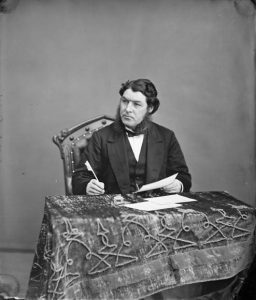Sir Charles Tupper
1821-1915
A former premier of Nova Scotia and Father of Confederation, Tupper held several important portfolios in Sir John A. Macdonald’s cabinets, including as Minister of Railways between 1879 and 1884 when the Canadian Pacific Railway was racing to completion, and later served as High Commissioner to Great Britain. He became Canada’s sixth prime minister in 1896 at the age of 75but governed only 10 weeks before Laurier defeated the Conservatives in a general election the same year (Tupper won the popular vote but lost the seat count).
Tupper and his wife Frances lived at 274 Daly Ave. between 1870 and 1874, just a block and a half away from Macdonald. Built around 1865 for Alfred Patrick, a clerk in the Legislative Assembly, this honey-coloured brick dwelling originally featured a graceful Second Empire roof, 14-foot ceilings on the main floor and marble fireplaces. Tupper sold the house in 1874 to Richard W. Scott, a former mayor of Bytown.
Tupper was the only Father of Confederation with a university education. He was the first president of the Canadian Medical Association and never ceased practicing his profession while a politician (he kept a medical bag under his front- bench seat in the House of Commons). He had a good reputation as a physician (his list of patients grew to include the Governor General) and earned as much income as a doctor as he did as a cabinet minister. As a country doctor in Nova Scotia, “he performed amputations in patients’ homes, sat beside children with scarlet fever and sewed up lacerations caused by farm implements” (Murray and Murray, 1999, p 39).
Tupper was the only Father of Confederation with a university education. He was the first president of the Canadian Medical Association and never ceased practicing his profession while a politician (he kept a medical bag under his front- bench seat in the House of Commons). He had a good reputation as a physician and earned as much income as a doctor as he did as a cabinet minister.

Tupper always enjoyed the company of women (in his younger days, he had been known as the “ram of Cumberland”) and he liked to flirt. When he lived on Daly Ave., he would make a short detour on his way to the office to “surprise” Mme Desbarats, the wife of the Queen’s Printer, at 213 Chapel St.[1] watering her flower garden, so much so that the neighbours feared that the flowers on that corner of the garden would drown.
An episode in the winter of 1869 showed his strength of character and love for his family. When Tupper learned that his daughter Emma was in danger in what is now southern Manitoba as a result of the Red River Rebellion (her husband, an army captain, was accompanying William McDougall on his ill-fated expedition to the Northwest), he decided to go rescue her. He left Halifax by boat to New York (there was no train service to Halifax yet) to catch a train to Ottawa where he met Sir John A. Macdonald and Donald Smith (the future Lord Strathcona who drove the Last Spike and had been recently-appointed Commissioner to the Northwest). Tupper and Smith then travelled by train to Toronto, Chicago and St Cloud, Minnesota, by stagecoach to Ft Abercrombie and finally by horse-drawn sleigh to Pembina. It was December, it was cold and the men were sometimes sleeping in buffalo hides in the snow. Despite the dangers – Red River was in open rebellion and Tupper was associated with Canada’s take-over of the colony – Tupper continued to Fort Garry (Winnipeg) where he met Louis Riel and obtained the release of his daughter’s seized horses, wagon and baggage. He took his daughter and son-in-law back to Ottawa and then continued home to Halifax where he arrived in late January after a journey that had lasted six weeks.
Tupper fought two federal elections in the years he lived at 274 Daly Ave., including the disastrous election of 1874 when the government was defeated and he was one of only two Conservatives elected in Nova Scotia.
His political influence derived from his vision – he coined the term “National Policy” to designate the tariff wall to protect Canadian industry – his political acumen, and by being Macdonald’s trusted confidant and chief political enforcer. Aggressive and ruthless, his debating style attracted several colourful contemporary descriptions. One of his political opponents, George Ross, said that he “wrestled with his subject as a strong man would wrestle in an amphitheatre.” (cited in Berton, 1971). Another noted slyly that “Sir John A. Macdonald steered the ship of state while Tupper provided the wind.” (Cited in Peacock, 2002)
He lived out his retirement in England where he died. A few years before his death, Sir Wilfrid Laurier paid tribute to Tupper by saying that “next to Macdonald, the man who did the most to bring Canada into Confederation is … Sir Charles Tupper” (cited in Murray and Murray, 1999). He is buried in Halifax.
[1] Sir Sandford Fleming would later live at that address.
